Looking back at my course expectations from Blog 1, I hoped to gain a better understanding of the relationship between culture and psychology so that I will be able to help my clients in my future career. I also hoped to gain more confidence and competency to perform my duties in my career of choice while also maintaining professionalism with my clients. The careers that I mentioned at the time included social work and professional counseling. Lately, I have been exploring the possibility of becoming a therapist. I feel that I have met these expectations, but I will not be able to apply the knowledge that I have learned until I work in the field.
Reflecting on the course objectives, I have learned a lot of valuable information that will resonate with me on my journey towards a career in psychology. I believe that I have met all the course objectives and there are a few that I would like to address. One of the course objectives includes getting acquainted with psychological research and theory that examines the influence of culture and psychology throughout the world. Many theories and research were discussed in this course, but I really enjoyed the module on culture, self, and identity. I learned about the independent and interdependent self-construals and how they relate to different aspects of the self. The other course objective I wanted to discuss deals with understanding cultural diversity and the impact of culture on human life. The module on enculturation was intriguing to me because I come from a family made up of two different cultures. I am half Filipino, and I grew up here in the United States. My mother grew up in the Philippines so naturally she has introduced me to some of her cultural norms. What I found particularly interesting was Bronfenbrenner’s ecological systems theory of human development that organizes the different dimensions of enculturation.
My attitude towards cross-cultural psychology has not changed much since the start of the semester. I am just as interested in it now than I was when I started. I think it is an important subject that is often overlooked. It is important to be knowledgeable in cultural psychology because of the variety of clients someone in the field of psychology will encounter. This does not only apply to those who work in the field of psychology, but it is also useful for anyone in their everyday interactions with people. If I took this class again, I would be more a little bit more organized in my preparation for exams. I would make more of an effort to use the PowerPoints to cross-reference what I find in the e-book.
Academically, my knowledge base has grown tremendously. I have developed a strong foundation not only in this class but my other classes as well. Other courses that I took during cross-cultural psychology include ethics, abnormal psychology, and psychology of adolescence. One skill that I learned in this course that I can use in my professional life relates to the E-portfolio. I was intimidated by it at first glance during week 1 of this course. However, as the weeks went by, I became more confident in my writing skills and my ability to critically think. I really enjoyed doing the E-portfolio assignments especially the blogs. Blogging allowed me to relate the material from class to my personal life. Navigating WordPress was also a challenge for me but now I feel more comfortable in using the website. Over the course of the semester, I believe my cultural competence has improved. It was interesting to learn about how culture and psychology relate to each through the explanation of various theories and empirical research studies. When I began the course, the only knowledge I had of culture was the definition of it. I did not realize the impact one’s culture can have on their psychological path. This is a course I wanted to take because I believe culture is an important subject when it comes to working in the field of psychology in interacting with different clients.
I chose the image below because it represents my growth over the semester. The watering can represents the lessons or modules that have watered the seeds in my brain and resulted in the seeds sprouting into plants. The sprouting represents the new knowledge that I have acquired through this class and I will carry with me in my journey through psychology.

Blog 9
With the semester ending soon I would like to reflect on some of the concepts I have learned in Cross-Cultural Psychology. I learned about the five-factor model to include the five dimensions of neuroticism, extraversion, openness, agreeableness, and conscientiousness. I also learned about its universality across different cultures. During Blog 3 I was able to take the NEO personality test and determine how I scored in each of the five dimensions. The next concept that I learned about was the independent and interdependent construal of self. It was very interesting to learn that internal attributes are related to the independent construal of self and interpersonal relationships are related to the interdependent construal of self. For Blog 5 I was able to come up with 10 statements about myself and then determine which construal of self was described by each statement. I found that I described myself in more interdependent ways. The last concept that I found to be very interesting pertained to the values within a culture. I learned that different countries value different things and differ in how they order them according to their importance within their culture. For ATA 2 I examined different values in American culture and chose to discuss the value of future orientation. Future orientation in American culture refers to how the future is more important than the past and what is happening now is important because it will lead to something better.
A concept that I discussed in one area that can be applied to another area in my Eportfolio is the concept of independent and interdependent construal of self. I discussed this concept in both Blog 5 and Artifact 2. For Blog 5 I made 10 statements about myself and determined which construal of self they related to. I found that the statements I made mostly reflected the interdependent construal of self because of the interpersonal relationships I recognize in my life. The other area in my Eportfolio that reflected the same concept is in Artifact 2 when I reflected on happy moments in my life and determined if those happy moments reflected the independent or interdependent construal of self. I chose my top happy moment of when I gave birth to my son and this reflected the interdependent construal of self and my associated emotions are socially engaged.
A concept that I discussed in one area of my Eportfolio that was discussed in another course relates to the Five-Factor Model of personality. In Cross-Cultural Psychology the FFM is discussed in terms of its importance in the relationship between personality and culture within the cross-cultural perspective. It is described as a model that is built around the five dimensions of openness, conscientiousness, extraversion, agreeableness, and neuroticism. This concept was also discussed in my Psychology of Adolescence class. It is described as The Big Five Factors of Personality of openness, conscientiousness, extraversion, agreeableness, and neuroticism. It is described in terms of personality development related to the development of adolescent identity. There are also sub traits associated within each major trait.
The image below is a note from my phone to represent my organizational process of exploring what I learned this semester.
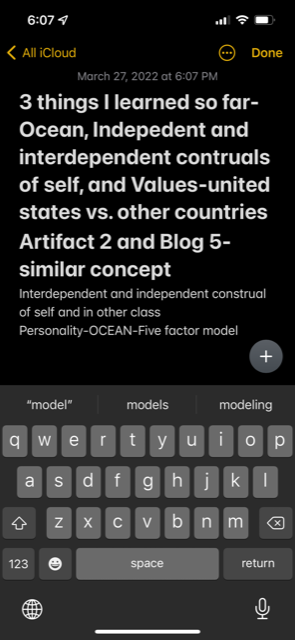
Blog 8
There have been many occasions in which I have noticed people from different cultures expressing themselves. After reading the article, Emotion Perception Across Cultures, it brought back some memories for me when I lived in Japan. I lived in Yokosuka, Japan for two years when I was in the Navy. I had many encounters with the locals, and I experience culture shock. The first thing that stood out to me was how polite everyone was. The locals smiled a lot. They smiled when they were happy, and they also smiled when they were uncomfortable or annoyed. This made it hard at times for me to gauge what emotion was being portrayed. It also did not help that I did not speak Japanese well. I also noticed that making eye contact was not very common. I later found out that looking at someone directly in the eyes is rude or aggressive.
Another example is when I rode the train for the first time. It was so quiet that anyone could hear a pin drop. It was alarming at first, but I started to notice how peaceful and considerate it was to not have to deal with loud and rowdy commutes to work every day. I attended a mandatory class on base during my first few weeks upon arrival. I learned that the reason it is quiet on the train is because the people do not want to disturb the “Wa.” Wa is a Japanese concept that translates to “harmony.” There is a peaceful unity that thrives in Japanese culture, and they are taught from an early age that maintaining a harmonious community is more important than their own personal interests.
The behaviors that I observed while I was in Japan were very different than what I expected. I did not expect such acceptance, courtesy, and consideration. I was worried about having issues while adjusting to my new duty station, but it ended up being the exact opposite. It was the first time that I had experienced a collectivistic culture and I appreciated it.
The concept of display rules can explain all my experiences. I experienced locals who smiled even when the emotion did not fit what was seen. If someone felt negative towards me because of something I said or if they felt confused or uneasy, they still smiled to be polite. According to the article, eastern cultures tend to focus on the eye area when expressing emotion and western culture tends to focus on the mouth area. Perhaps because I am from western culture, I am noticing their smiles because I’m focusing on the mouth region. The fact that eye contact was not common can also be explained by display rules. Japanese people tend to let their gaze fall elsewhere other than the eye region. According to the article, their gaze tends to fall at the neckline. The silence on the train can also be explained by display rules because according to the article, Japanese people tend to conceal their negative emotions to maintain harmony.
The image below includes emoticons of both western and Japanese culture. I chose this because it emphasizes the differences in how emotions are displayed and interpreted.
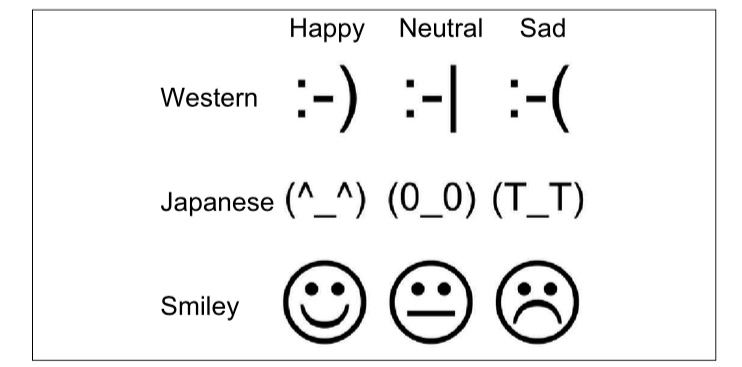
Blog 7
After reading the article “Tale As Old As Time,” I believe that fairy tales told to young audiences can reflect a shared set of cultural normal and values depending on the country in which they are told. Some countries may reflect very conservative views while others may take a more liberal approach. It can be said that older Disney movies and films of the like reflect different cultural norms and values than they do today. The cultural norms and values of the United States where we live are constantly changing and more and more inclusiveness has been displayed especially in the media and pop culture.
Some examples in which the main character in fairy tales can be seen modeling more egalitarian roles includes the interdependent relationships with other characters in the story. The other characters in the story may include those who are dissimilar from the main character in the way they look, act, where they’re from, their values, their socio-economic status, gender identity, gender roles, etc. However, when the main character is seen displaying egalitarian roles towards others, it may encourage young people to do the same. This can have a positive effect on how young people interact with people by showing mutual respect and equal treatment towards others. An example of a movie in which the main character has a positive influence can be seen the Disney movie “Brave.” The main character, Merida, shows that she is just as strong as the men by showcasing her abilities with shooting arrows and not fitting into her society’s expectation of women. She has unkept hair and does not prefer the typical princess wardrobe to include dresses. She is tough, fierce, and capable and this sends a positive message to the youth.
The image below is a poster for the Disney movie “Brave.” I chose this specific image because it displays Merida breaking gender stereotypes by showing her ability to shoot arrows, her fierce look and stance, and messy hair. It also shows that bravery does not have a specific look.

Blog 6
When examining the self-determination theory, it describes that all cultures are similar because of their psychological needs relating to autonomy, competence, and relatedness. However, there is a difference in the way these needs are met and presented across diverse cultures. Autonomy is when a person’s actions align with their personal values, interests, and desires. Regarding my academics, I satisfy my need for autonomy by staying on top of my assignments and planning my weeks. I do this because I want to set myself up for success. Competence describes a person’s need to feel like their actions are effective. They want to feel like they are doing a decent job. I fulfill my need for competence by doing well in my classes and getting grades that make me feel like I am taking the right steps to ensure my academic success. This makes me feel competent. Relatedness is a person’s need to feel connected to other people or have meaningful experiences and relationships with others. I satisfy my need for relatedness by going to my classes and making connections during class discussions with my classmates as well as my professors.
I chose the image below because this person has just graduated and when it comes time for me to graduate, my needs for autonomy, competence, and relatedness will be fulfilled in relation to my academic success.

Blog 5
This week I had to come up with 10 statements that describe who I am and determine whether my statements are related to the independent or interdependent construal of self. When examining these statements, I found that the first three statements are associated with the independent construal of self. I wrote the following: I am capable, I am strong, and I am worthy. The rest of my statements are associated with the interdependent construal of self. I wrote the following: I am a good mother, I am a good wife, I am an imperfect person, I am loving, I am a hard worker, I am kind to everyone, and I am an empathetic person. Based on my 10 statements, I would definitely say that I am more interdependent.
When I made the statements, I am capable, I am strong, and I am worthy, I believe these are reflective of English proverbs associated with the independent construal of self because they are unique to me. They represent my internal attributes that exist outside of my interactions and relationships with others. When I made the statements of being a good mother, a good wife, and a hard worker, these are reflective of English proverbs relating to the interdependent construal of self. This is due to the interpersonal relationships I have with others such as my family, friends, and those I interact with on a daily basis. In other words, I am stating my assigned roles within those relationships. I personally thought it was easier to think of the proverbs that reflect the independent self because I can easily think about what makes me unique and how I view myself internally versus externally and how my interactions with others in certain settings influence who I am. This was surprisingly to realize because majority of my statements would suggest that I am more interdependent.
I chose the image below because it illustrates the differences between the independent construal of self and the interdependent construal of self. It helps in visualizing the internal attributes that exist within the independent construal of self and the interpersonal relationships that also exist within the interdependent construal of self.
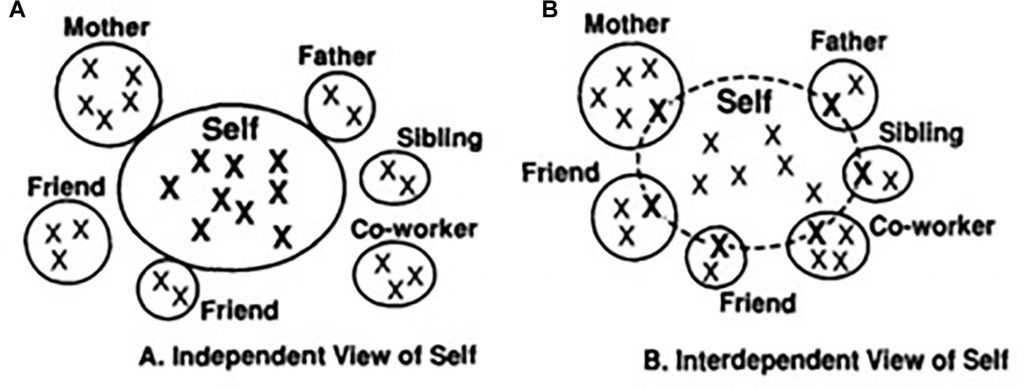
Blog 4
After reviewing my exam 1 results, I realize that I need be a little bit more organized in my preparation for exams. My focus should be on the smaller details that I may have skimmed over in the textbook. I prepared by using the textbook, study guide, and the power points. For every bullet on the study guide, I copied the information that I found in the textbook and pasted it under each bullet. I also indicated which slide in the power points each bullet could be found. I highlighted anything on the study guide and the power points that I struggled to remember to hopefully reinforce the information. I studied every day over a week span. After reflecting on exam 1, I will stay focused and plan to start studying a few weeks prior to the exam rather than 1 one week before. I will also take the time to read the textbook first before looking at the power points. I will play attention to the smaller details in the text that may be on the exam.
I chose the image below because it is a good representation of me when it comes to procrastination. I try my best to get things done in a timely manner but there are times when I am easily distracted with my devices and the notifications that come through. This causes me to sometimes put things off until “later.”

Blog 3
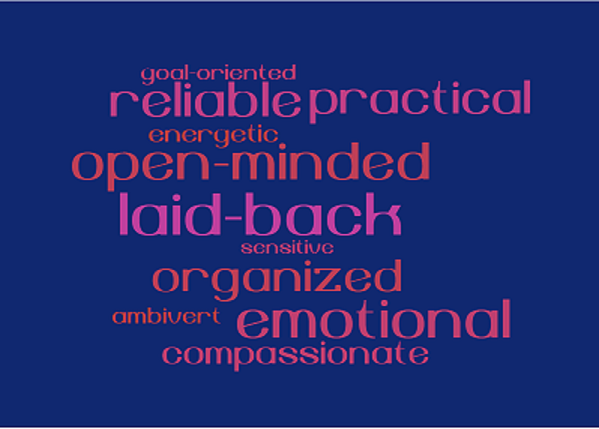
After taking the NEO personality test I must be honest and say that I was not surprised at all by my results. In the area of Openness I scored a 31 which is considered to be average. This is fitting for my personality because I am a practical person and I appreciate new ideas yet I respect old ideas as well. For example, I am somewhat of a realist and open to trying new things such as eating new foods and meeting new people. However, I do find comfort in things that are familiar.
In the area of Conscientiousness I scored a 37 which is considered to be average. This fits my personality because I am someone that people can rely on. For example, when I say I will do something, I almost always will. I take pride in keeping myself organized especially when it comes to school and keeping a tidy household. I work hard to reach my goals but I also know when it is time to relax. I like to find the balance in everyday life. After a hard day of school work I usually like to settle down with relaxing music and tea.
In the area of Extraversion I scored a 28 which is considered average. This is also fitting for my personality because I am an enthusiastic person. For example, I enjoy the company of my friends on the weekends but sometimes my social meter gets full and I need some time to myself. Often times, I find myself going weeks in between seeing friends. I am indeed an ambivert.
In the area of Agreeableness I scored a 35 which is considered high. This is accurate for my personality because I am a compassionate person, good-natured, and I am a non-confrontational person. For example, I am the most empathetic person I know and I am an excellent listener. I am usually the one my friends call upon when something goes wrong. I also like to handle bad situations calmly rather than aggressively.
In the area of Neuroticism I scored a 29 which is considered high. This fits my personality because I am sensitive and emotional. I feel all my feelings and sometimes all at once. For example, there are times when I bottle up my emotions until I can no longer keep them to myself. It also does not help that I am non-confrontational because I struggle with expressing firmly to someone if they have wronged me.
I chose to use the image above because it represents all the personality traits that best suit me. When I see those words they almost solidify my personality and what makes me unique. It it almost empowering to see those words. This activity was enlightening and I thoroughly enjoyed it.
Blog 2
Some life values that are important to me include authenticity, balance, and respect. All of these will be relevant in my potential careers. As someone who has struggled with people-pleasing, I have recently been trying my best to be my most authentic self when around my family and peers. This is hard at times and it’s tempting to revert to my old habits of people pleasing but I know that being authentic will be important in my profession. I want my clients to know that I am genuine in my interactions with them. I also value balance because I want to have a good work-life balance when I start my career. I value being a good mother and wife while also maintaining a career. It will be very important to me to separate my professional life from my personal life. I value respect for myself and those around me and this will be important in my career as a social worker or professional counselor. Self-respect is vital in rendering that same respect to other people.
My eagerness to learn and the joy it brings me to help people are what have made these pursuits possible. I have always prioritized my education and being the friend who was usually approached in difficult situations or just to lend a listening ear, it was only natural for me to pursue a career in which I can continue to help others. I decided to continue on to higher education because the world is always changing, therefore, we can always learn something new and apply it to everyday life. I have been pursuing higher education since 2010. My parents, especially my mother, have always pushed education for me and my siblings because they believe that earning an education leads to success. Seeing my peers in high school apply to different colleges also gave me the motivation to pursue college as well. My teachers in high school anticipated that most students would be applying to colleges and some of them even offered their help in walking students through the process. I started out with community college, so I did not have to leave home, and this made the transition much easier.
I chose to add this picture of my bookshelf because it represents my love for learning through reading. I truly enjoy reading books that can add to my values of authenticity, finding balance, and respect. Books can help shape a person to become who they truly want to be or simply enlighten them especially if they enjoy reading books on self-improvement.
My Bookshelf
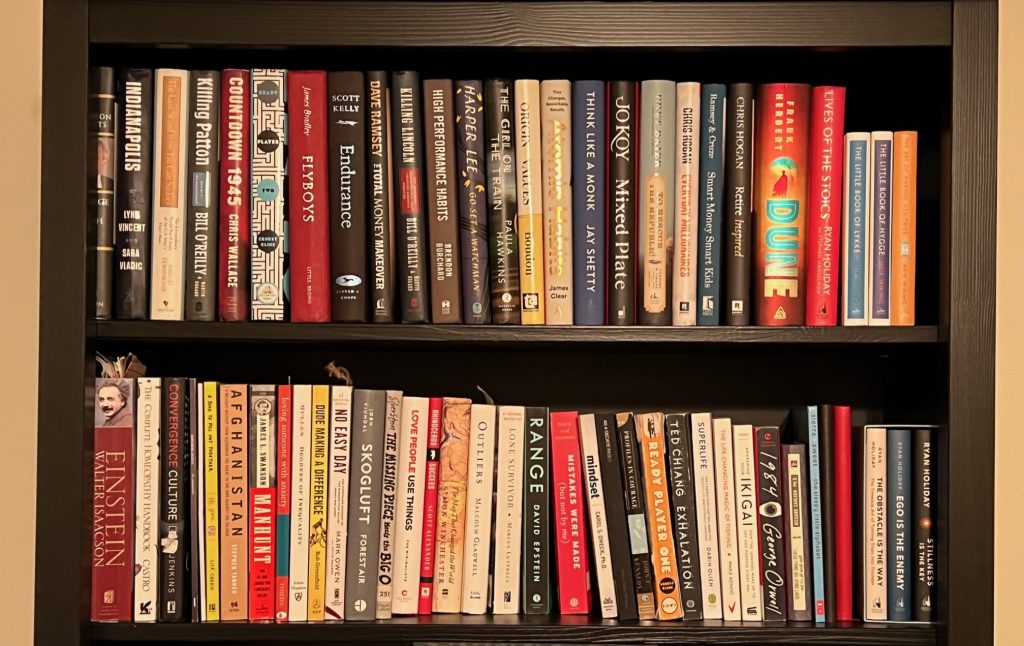
Blog 1
Upon reading the course objectives, I am confident that they will aid me in my potential line of work in the field of social work or professional counseling. Understanding cultural diversity and its impact on human life and how culture and psychology influence the world will be helpful in those fields and will lead to becoming more interculturally competent. A glimpse into the psychological research and theory associated with culture and psychology will further develop the critical thinking skills I will need in real-life situations. All these course objectives will be valuable tools in interacting with my clients.
In this course, I am hoping to gain a better understanding of the relationship between culture and psychology so that I can perform to the best of my ability in my future career. I would like to gain the confidence and competency to do my job while maintaining professionalism. To ensure my success in this course I will need to stay organized. I currently maintain a planner in which I write my assignments on a weekly basis. I write all the readings, assignments, tests, and all their due dates. I chose the image below because it is a representation of the cultural diversity that exists in our world and the unique connections that we have with each other.
A world of culture
